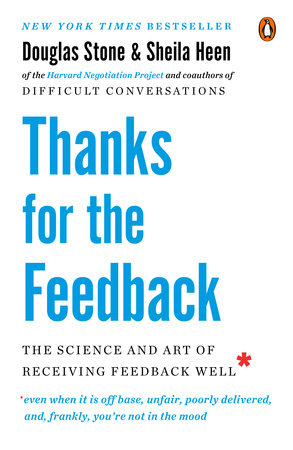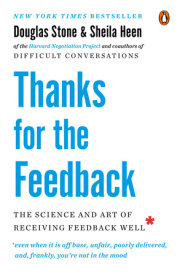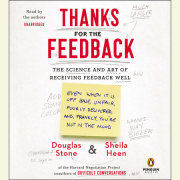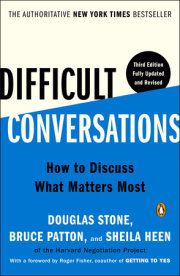Before you tell me how to do it better, before you lay out your big plans for changing, fixing, and improving me, before you teach me how to pick myself up and dust myself off so that I can be shiny and successful—know this: I’ve heard it before.
I’ve been graded, rated, and ranked. Coached, screened, and scored. I’ve been picked first, picked last, and not picked at all. And that was just kindergarten.
We swim in an ocean of feedback.
Each year in the United States alone, every schoolchild will be handed back as many as 300 assignments, papers, and tests. Millions of kids will be assessed as they try out for a team or audition to be cast in a school play. Almost 2 million teenagers will receive SAT scores and face college verdicts thick and thin. At least 40 million people will be sizing up one another for love online, where 71 percent of them believe they can judge love at first sight. And now that we know each other . . . 250,000 weddings will be called off, and 877,000 spouses will file for divorce.1
More feedback awaits at work. Twelve million people will lose a job and countless others will worry that they may be next. More than 500,000 entrepreneurs will open their doors for the first time, and almost 600,000 will shut theirs for the last. Thousands of other businesses will struggle to get by as debates proliferate in the boardroom and the back hall about why they are struggling. Feedback flies.2
Did we mention performance reviews? Estimates suggest that between 50 and 90 percent of employees will receive performance reviews this year, upon which our raises, bonuses, promotions—and often our self-esteem—ride. Across the globe, 825 million work hours—a cumulative 94,000 years—are spent each year preparing for and engaging in annual reviews. Afterward we all certainly feel thousands of years older, but are we any wiser?3
Margie receives a “Meets Expectations,” which sounds to her like “Really, You Still Work Here?”
Your second grader’s art project, “Mommy Yells,” was a hot topic at the school’s Open House Night.
Your spouse has been complaining about your same character flaws for years. You think of this less as your spouse “giving you feedback,” and more as your spouse “being annoying.”
Rodrigo reads over his 360-degree feedback report.4 Repeatedly. He can’t make head or tail of it, but one thing has changed: He now feels awkward with his colleagues, all 360 degrees of them.
Thanks for the Feedback is about the profound challenge of being on the receiving end of feedback—good or bad, right or wrong, flippant, caring, or callous. This book is not a paean to improvement or a pep talk on how to make friends with your mistakes. There is encouragement here, but our primary purpose is to take an honest look at why receiving feedback is hard, and to provide a framework and some tools that can help you metabolize challenging, even crazy-making information and use it to fuel insight and growth.
• • •
In 1999, along with our friend and colleague Bruce Patton, we published Difficult Conversations: How to Discuss What Matters Most. Since then, we’ve continued to teach at Harvard Law School and to work with clients across continents, cultures, and industries. We’ve had the privilege of working with an amazing assortment of people: executives, entrepreneurs, oil rig operators, doctors, nurses, teachers, scientists, engineers, religious leaders, police officers, filmmakers, lawyers, journalists, and relief workers. Even dance instructors and astronauts.
Here’s something we noticed early on: When we ask people to list their most difficult conversations, feedback always comes up. It doesn’t matter who they are, where they are, what they do, or why they brought us in. They describe just how tough it is to give honest feedback, even when they know it’s sorely needed. They tell us about performance problems that go unaddressed for years and explain that when they finally give the feedback, it rarely goes well. The coworker is upset and defensive, and ends up less motivated, not more. Given how hard it is to muster the courage and energy to give feedback in the first place, and the dispiriting results—well, who needs it?
Eventually, someone in the group will pipe up to observe that getting feedback is often no easier. The feedback is unfair or off base. It’s poorly timed and even more poorly delivered. And it’s not clear why the giver thinks they are qualified to offer an opinion; they may be the boss, but they don’t really understand what we do or the constraints we’re under. We are left feeling underappreciated, demotivated, and more than a little indignant. Who needs it?
Interesting. When we give feedback, we notice that the receiver isn’t good at receiving it. When we receive feedback, we notice that the giver isn’t good at giving it.
We wondered: What is it that makes feedback such a conundrum for both givers and receivers? We started listening closely to people as they described their dilemmas, struggles, and triumphs, and noticed those same struggles in ourselves. As we worked to develop ways to approach feedback differently, we soon realized that the key player is not the giver, but the receiver. And we came to see how this could transform not just how we handle performance reviews on the job, but how we learn, lead, and behave in our professional roles and in our personal lives.
Feedback includes any information you get about yourself. In the broadest sense, it’s how we learn about ourselves from our experiences and from other people—how we learn from life. It’s your annual performance review, the firm’s climate survey, the local critic’s review of your restaurant. But feedback also includes the way your son’s eyes light up when he spots you in the audience and the way your friend surreptitiously slips off the sweater you knitted her the minute she thinks you’re out of view. It’s the steady renewal of services by a longtime client and the lecture you get from the cop on the side of the road. It’s what your bum knee is trying to tell you about your diminishing spryness, and the confusing mix of affection and disdain you get from your fifteen-year-old.
So feedback is not just what gets ranked; it’s what gets thanked, commented on, and invited back or dropped. Feedback can be formal or informal, direct or implicit; it can be blunt or baroque, totally obvious or so subtle that you’re not sure what it is.
Like that comment your spouse made a moment ago: “I don’t like the way those pants look on you.” What do you mean, you don’t like the way these pants look on me? Is there something wrong with this particular pair of pants, or was that a passive-aggressive reference to the weight I’ve put on? Another dig about how I’m living in the past or can’t dress myself, even as an adult? Are you trying to help me look nice for the party, or is this your way of easing into asking for a divorce? (What do you mean I’m overreacting?)
The term “feed-back” was coined in the 1860s during the Industrial Revolution to describe the way that outputs of energy, momentum, or signals are returned to their point of origin in a mechanical system.5 By 1909 Nobel laureate Karl Braun was using the phrase to describe the coupling and loops between components of an electronic circuit. A decade later the new compound word “feedback” was being used to describe the recirculating sound loop in an amplification system—that piercing squeal we all know from high school auditoriums and Jimi Hendrix recordings.
Sometime after World War II the term began to be used in industrial relations when talking about people and performance management. Feed corrective information back to the point of origin—that would be you, the employee—and voilà! Tighten up here, dial back there, and like some Dr. Seuss contraption, you’re all tuned up for optimum, star-bellied performance.
In today’s workplace, feedback plays a crucial role in developing talent, improving morale, aligning teams, solving problems, and boosting the bottom line. And yet. Fifty-one percent of respondents in one recent study said their performance review was unfair or inaccurate, and one in four employees dreads their performance review more than anything else in their working lives.6
The news is no more encouraging on the manager’s side: Only 28 percent of HR professionals believe their managers focus on more than simply completing forms. Sixty-three percent of executives surveyed say that their biggest challenge to effective performance management is that their managers lack the courage and ability to have difficult feedback discussions.7
Something isn’t working. So organizations are spending billions of dollars each year to train supervisors, managers, and leaders on how to give feedback more effectively. When feedback meets resistance or is rejected outright, feedback givers are encouraged to be persistent. They are taught how to push harder.
We think we have it backwards.
Training managers how to give feedback—how to push more effectively—can be helpful. But if the receiver isn’t willing or able to absorb the feedback, then there’s only so far persistence or even skillful delivery can go. It doesn’t matter how much authority or power a feedback giver has; the receivers are in control of what they do and don’t let in, how they make sense of what they’re hearing, and whether they choose to change.
Pushing harder rarely opens the door to genuine learning. The focus should not be on teaching feedback givers to give. The focus—at work and at home—should be on feedback receivers, helping us all to become more skillful learners.
The real leverage is creating pull.
Creating pull is about mastering the skills required to drive our own learning; it’s about how to recognize and manage our resistance, how to engage in feedback conversations with confidence and curiosity, and even when the feedback seems wrong, how to find insight that might help us grow. It’s also about how to stand up for who we are and how we see the world, and ask for what we need. It’s about how to learn from feedback—yes, even when it is off base, unfair, poorly delivered, and frankly, you’re not in the mood.
We like the word “pull” because it highlights a truth often ignored: that the key variable in your growth is not your teacher or your supervisor. It’s you. It’s well and good to hope for that special mentor or coach (and cherish the ones you come across). But don’t put off learning until they arrive. Those exceptional teachers and mentors are rare. Mostly, our lives are populated by everyone else—people who are doing their best but may not know better, who are too busy to give us the time we need, who are difficult themselves, or who are just plain lousy at giving feedback or coaching. The majority of our learning is going to have to come from folks like these, so if we’re serious about growth and improvement, we have no choice but to get good at learning from just about anyone.
It seems like that shouldn’t be so hard. After all, humans are naturally wired for learning. The drive to learn is evident from infancy and rampant by toddlerhood. Even as adults we memorize baseball stats, travel in retirement, and throw ourselves into yoga because discovery and progress are deeply gratifying. Indeed, research on happiness identifies ongoing learning and growth as a core ingredient of satisfaction in life.
We may be wired to learn, but it turns out that learning about ourselves is a whole different ball game. Learning about ourselves can be painful—sometimes brutally so—and the feedback is often delivered with a forehead-slapping lack of awareness for what makes people tick. It can feel less like a “gift of learning” and more like a colonoscopy.
Tom’s boss gives him a dressing-down about his “organizational skills.” On his drive home, Tom silently catalogues his boss’s inadequacies. He pulls over and jots down a list to keep them organized.
Monisha, the head of HR, hoped the grim results from the firm’s climate survey would spark candid conversation among senior leadership about the need for change. Instead, she got a terse e-mail from the CFO enumerating the survey’s methodological flaws, dismissing the results, and questioning Monisha’s motives.
Kendra’s sister-in-law lets slip that the family thinks she is hysterically overprotective of her children. Perhaps not precisely those words, but that’s the tape running in Kendra’s mind as she sets the table for the extended family Sunday dinner.
It’s no wonder that when we see tough feedback coming, we are tempted to turn and run.
But we know we can’t just tra-la-la down the road of life ignoring what others have to say, safely sealed in our emotional Ziploc. We’ve heard it since we were young. Feedback is good for you—like exercise and broccoli. It makes you stronger and helps you grow. Doesn’t it?
It does. And our life experiences confirm it. We’ve all had a coach or family member who nurtured our talent and believed in us when no one else did. We’ve had a friend who laid bare a hard truth that helped us over an impossible hurdle. We’ve seen our confidence and capabilities grow, our relationships righted, and our rough edges softened. In fact, looking back, we have to admit that even that horrendous ex-spouse or overbearing supervisor taught us as much about ourselves as those who were on our side. It wasn’t easy, but we know ourselves better now, and like ourselves more.
So here we are. Torn. Is it possible that feedback is like a gift and like a colonoscopy? Should we hang in there and take it, or turn and run? Is the learning really worth the pain?
We are conflicted.
Here’s one reason why. In addition to our desire to learn and improve, we long for something else that is fundamental: to be loved, accepted, and respected just as we are. And the very fact of feedback suggests that how we are is not quite okay. So we bristle: Why can’t you accept me for who I am and how I am? Why are there always more adjustments, more upgrades? Why is it so hard for you to understand me? Hey boss, hey team. Hey wife, hey Dad. Here I am. This is me.
Receiving feedback sits at the intersection of these two needs—our drive to learn and our longing for acceptance. These needs run deep, and the tension between them is not going away. But there’s a lot each of us can do to manage the tension—to reduce anxiety in the face of feedback and to learn in spite of the fear. We believe that the ability to receive feedback well is not an inborn trait but a skill that can be cultivated. It may be fraught, but it can be taught. Whether you currently think of yourself as someone who receives feedback well or poorly, you can get better. This book shows you how.
Receiving feedback well doesn’t mean you always have to take the feedback. Receiving it well means engaging in the conversation skillfully and making thoughtful choices about whether and how to use the information and what you’re learning. It’s about managing your emotional triggers so that you can take in what the other person is telling you, and being open to seeing yourself in new ways. And sometimes, as we discuss in chapter 10, it’s about setting boundaries and saying no.
The bold-faced benefits of receiving feedback well are clear: Our relationships are richer, our self-esteem more secure, and, of course, we learn—we get better at things and feel good about that. And perhaps most important to some of us, when we get good at receiving feedback even our toughest feedback interactions come to feel a little less threatening.
In the workplace, treating feedback not just as something to be endured, but something to be actively sought, can have a profound impact. Feedback-seeking behavior—as it’s called in the research literature—has been linked to higher job satisfaction, greater creativity on the job, faster adaptation in a new organization or role, and lower turnover. And seeking out negative feedback is associated with higher performance ratings.8
Perhaps this isn’t surprising. People who are willing to look at themselves are just easier to work with and to live with. Being with people who are grounded and open is energizing. When you’re open to feedback your working relationships have more trust and more humor, you collaborate more productively and solve problems more easily.
In personal relationships, our ability to deal with complaints, requests, and coaching from our friends and loved ones is crucial. Even in the best relationships we get frustrated with each other; we hurt each other accidentally and—on occasion—on purpose. Our ability to sort out how we’re feeling, why we’re upset, where we are bumping into one another, drives the long-term health and happiness of those relationships. Marriage researcher John Gottman has found that a person’s willingness and ability to accept influence and input from their spouse is a key predictor of a healthy, stable marriage.9
In contrast, working or living with someone who shuts out feedback or responds with defensiveness and arguments is exhausting. We walk on eggshells and live in fear of pointless conflicts. Frank discussion fades and feedback goes unspoken, depriving the “receiver” of the chance to understand what’s gone wrong or to fix it. The transaction costs involved in the simplest problem solving become prohibitive, and important thoughts and feelings have no outlet. Problems fester and the relationship stagnates. Insulation leads to isolation.
That’s not just depressing, it’s destructive, particularly today. Columnist Thomas Friedman observes, “We’re entering a world that increasingly rewards individual aspiration and persistence and can measure precisely who is contributing and who is not. If you are self-motivated, wow, this world is tailored for you. The boundaries are all gone. But if you’re not self-motivated, this world will be a challenge because the walls, ceilings and floors that protected people are also disappearing.”10
The rewards are great, and the stakes have never been higher.
This suggests that it’s not just about us; it’s also about our kids. Whether or not we realize it, how we talk about an unfair performance evaluation in front of our children teaches them how to react to a bad call that costs them the ball game. Our kids respond to tough challenges the way they see us respond to tough challenges. Will a bully’s name-calling eat away at their self-image? They will look to how we respond to our own setbacks; that teaches them more about resilience than all our pep talks and lectures combined.
The transformative impact of modeling is crucial at work as well. If you seek out coaching, your direct reports will seek out coaching. If you take responsibility for your mistakes, your peers will be encouraged to fess up as well; if you try out a suggestion from a coworker, they will be more open to trying out your suggestions. And this modeling effect becomes more important as you move up in an organization. Nothing affects the learning culture of an organization more than the skill with which its executive team receives feedback. And of course, as you move up, candid coaching becomes increasingly scarce, so you have to work harder to get it. But doing so sets the tone and creates an organizational culture of learning, problem solving, and adaptive high performance.
There is an old joke about a happy young optimist whose parents are trying to teach him to see the world more realistically. To that end, they decide to give him a large sack of horse dung for his birthday.
“What did you get?” asks his grandmother, wrinkling her nose at the smell.
“I don’t know,” cries the boy with delight as he excitedly digs through the dung. “But I think there’s a pony in here somewhere!”
Receiving feedback can be like that. It’s not always pleasant. But there just might be a pony in there somewhere.
Let’s start with some good news. Not all feedback is difficult. Your son’s teacher, astonishingly, praises his social skills. Your customer offers a clever suggestion about how to handle his order that expedites the process. You want bangs, but your hairdresser has a better idea, which is, actually, a better idea. We get this sort of feedback all the time. It helps or it doesn’t, and either way we’re not much bothered by it.
Most of us do just fine with positive feedback, although even praise can sometimes leave us uneasy. Perhaps we’re not sure it’s genuine or we fear we haven’t earned it. But closing the deal, or learning that someone you admire admires you, or getting that perfect bit of coaching that kicks your skill level up a notch can be electrifying. We did it, it worked, someone likes us.
Then there’s the tougher stuff—the feedback that leaves us confused or enraged, flustered or flattened. You’re attacking my child, my career, my character? You’re going to leave me off the team? Is that really what you think of me?
This kind of feedback triggers us: Our heart pounds, our stomach clenches, our thoughts race and scatter. We usually think of that surge of emotion as being “in the way”—a distraction to be brushed aside, an obstacle to overcome. After all, when we’re in the grip of a triggered reaction we feel lousy, the world looks darker, and our usual communication skills slip just out of reach. We can’t think, we can’t learn, and so we defend, attack, or withdraw in defeat.
But pushing our triggered reactions aside or pretending they don’t exist is not the answer. Trying to ignore a triggered reaction without first identifying its cause is like dealing with a fire by disconnecting the smoke alarm.
So triggers are obstacles, but they aren’t only obstacles. Triggers are also information—a kind of map—that can help us locate the source of the trouble. Understanding our triggers and sorting out what set them off are the keys to managing our reactions and engaging in feedback conversations with skill.
Let’s take a closer look at that map.
Because feedback givers are abundant and our shortcomings seemingly boundless, we imagine that feedback can trigger us in a googolplex of ways. But here’s more good news:
There are only three.
We call them “Truth Triggers,” “Relationship Triggers,” and “Identity Triggers.” Each is set off for different reasons, and each provokes a different set of reactions and responses from us.
Truth Triggers are set off by the substance of the feedback itself—it’s somehow off, unhelpful, or simply untrue. In response, we feel indignant, wronged, and exasperated. Miriam experiences a truth trigger when her husband tells her she was “unfriendly and aloof” at his nephew’s bar mitzvah. “Unfriendly? Was I supposed to get up on the table and tap dance?” This feedback is ridiculous. It is just plain wrong.
Relationship Triggers are tripped by the particular person who is giving us this gift of feedback. All feedback is colored by the relationship between giver and receiver, and we can have reactions based on what we believe about the giver (they’ve got no credibility on this topic!) or how we feel treated by the giver (after all I’ve done for you, I get this kind of petty criticism?). Our focus shifts from the feedback itself to the audacity of the person delivering it (are they malicious or just stupid?).
By contrast, Identity Triggers focus neither on the feedback nor on the person offering it. Identity triggers are all about us. Whether the feedback is right or wrong, wise or witless, something about it has caused our identity—our sense of who we are—to come undone. We feel overwhelmed, threatened, ashamed, or off balance. We’re suddenly unsure what to think about ourselves, and question what we stand for. When we’re in this state, the past can look damning and the future bleak. That’s the identity trigger talking, and once it gets tripped, a nuanced discussion of our strengths and weaknesses is not in the cards. We’re just trying to survive.
Is there anything wrong with any of the reactions above? If the feedback is genuinely off target or the person giving it has proven untrustworthy, or we feel threatened and off balance, aren’t these responses pretty reasonable?
They are.
Our triggered reactions are not obstacles because they are unreasonable. Our triggers are obstacles because they keep us from engaging skillfully in the conversation. Receiving feedback well is a process of sorting and filtering—of learning how the other person sees things; of trying on ideas that at first seem a poor fit; of experimenting. And of shelving or discarding the parts of the feedback that in the end seem off or not what you need right now.
And it’s not just the receiver who learns. During an effective conversation, the feedback giver may come to see why their advice is unhelpful or their assessment unfair, and both parties may understand their relationship in a clarifying light. They each see how they are reacting to the other, showing a way forward that’s more productive than what either imagined before.
But it’s nearly impossible to do any of this from inside our triggers. And so we make mistakes that cause us to put potentially valuable feedback into the discard pile, or just as damaging, we take to heart feedback that is better left at the curb.
Let’s look more closely at each of the three triggers and get an overview of what we can do to manage them more effectively.
There are lots of good reasons not to take feedback, and at the front of the line stands this one: it’s wrong. The advice is bad, the evaluation is unjust, the perception someone has of us is outdated or incomplete. We reject, defend, or counterattack, sometimes in the conversation but always in our minds.
But understanding the feedback we get well enough to evaluate it fairly turns out to be much harder than it appears. Below are three reasons why and what helps.
The first challenge in understanding feedback is that, surprisingly often, we don’t know whether it is feedback, and if it is, we’re not sure exactly what kind it is or how on earth it’s supposed to help us. Yes, we did ask for feedback; no, we did not ask for whatever it is that they’ve just offered us.
Part of the problem is that the word “feedback” can mean a number of different things. A pat on the back is feedback, and so is a dressing-down. Helpful pointers are feedback, and so is getting voted off the island. These aren’t just positive and negative; they’re fundamentally different kinds of feedback, with entirely different purposes.
The very first task in assessing feedback is figuring out what kind of feedback we are dealing with. Broadly, feedback comes in three forms: appreciation (thanks), coaching (here’s a better way to do it), and evaluation (here’s where you stand). Often the receiver wants or hears one kind of feedback, while the giver actually means another. You finally show your professional artist friend the self-portrait you painted. At this stage of your development, what you need is a little encouragement, something along the lines of “Hey, cool. Keep working at it.” What you get instead is a list of twelve things you need to fix.
We can flip this story. You showed your work to your professional artist friend because you were hoping for a list of twelve things to fix, and instead get a “Hey, cool. Keep working at it.” How is that going to help you get better?
Know what you want, and know what you’re getting. The match matters.
Sounds obvious, seems easy: Before you figure out what to do with the feedback, make sure you understand it. Like us, you probably think you’re doing this already. You listen to the feedback. You accept it or you reject it. But in the context of receiving feedback, “understanding” what the other person means—what they see, what they’re worried about, what they’re recommending—is not so easy. In fact, it’s flat-out hard.
Consider Kip and Nancy. They work for an organization that recruits talent for sought-after jobs overseas. Nancy tells Kip that he seems biased against candidates with nontraditional backgrounds. Nancy says that his bias is “seeping through” during interviews.
At first, Kip dismisses this feedback. His bias does not “seep through” because he does not have a bias. In fact, although Nancy is unaware of it, Kip himself has a nontraditional background, and if anything, he worries that he tends to favor candidates who’ve had the initiative to chart their own course in life.
So as far as Kip can tell, this feedback is simply wrong. Are we suggesting that he should accept it as right, nonetheless? No. We’re saying that Kip doesn’t yet know what the feedback actually means. The first step is for him to work harder to understand exactly what Nancy sees that is causing concern.
Kip eventually asks Nancy to clarify her feedback, and she explains: “When you interview traditional candidates, you describe common challenges the job presents, and observe how they reason through it. With nontraditional candidates, you don’t discuss the job. You just shoot the breeze about the candidate’s coffee cart business or travels with the merchant marine. You’re not taking them seriously.”
Kip is starting to understand and offers Nancy his view in response: “In my mind, I’m taking them very seriously. I’m listening for their persistence and resourcefulness—critical skills for demanding overseas jobs with unclear boundaries and harsh conditions. That’s better than presenting some hypothetical challenge.”
Following the guideline to first understand, Kip is getting a sense of where Nancy is coming from and Nancy is getting a sense of Kip’s perspective. A good start, but as we’ll see below, there’s still a ways to go.
Complicating our desire to understand feedback is the matter of blind spots. Of course, you don’t have blind spots, but you know that your colleagues, family, and friends certainly do. That’s the nature of blind spots. We’re not only blind to certain things about ourselves; we’re also blind to the fact that we’re blind. Yet, gallingly, our blind spots are glaringly obvious to everybody else.
This is a key cause for confusion in feedback conversations. Sometimes feedback that we know is wrong really is wrong. And sometimes, it’s just feedback in our blind spot.
Let’s come back to Kip and Nancy. Nancy sees something important that Kip can’t: Kip. She watches and hears Kip when he is conducting interviews. She’s noticed that Kip is more animated when he interviews nontraditional candidates; he talks louder and interrupts more often, giving them less space—and sometimes almost no space—to make their case.
Kip is so surprised by this observation that he can barely believe it’s true. He simply was not aware he was doing that. And he’s dismayed: If what Nancy is saying is right, then despite his good intentions, he might actually be disadvantaging the candidates that he is most excited to talk to. His slight bias in favor of these nontraditional candidates is actually working against them.
So Kip and Nancy have each learned something from their conversation. Nancy understands Kip’s intentions in a more generous light, and Kip is starting to get a handle on how his behavior is actually affecting the interviews. The conversation isn’t over, but they are in a better place to straighten things out.
Managing truth triggers is not about pretending there’s something to learn, or saying you think it’s right if you think it’s wrong. It’s about recognizing that it’s always more complicated than it appears and working hard to first understand. And even if you decide that 90 percent of the feedback is off target, that last golden 10 percent might be just the insight you need to grow.
Our perception of feedback is inevitably influenced (and sometimes tainted) by who is giving it to us. We can be triggered by something about the giver—their (lack of) credibility, (un)trustworthiness, or (questionable) motives. We can likewise be triggered by how we feel treated by that person. Do they appreciate us? Are they delivering the feedback in a respectful manner (by e-mail? Are you kidding?). Are they blaming us when the real problem is them? Our twenty years of simmering history together can intensify our reaction, but interestingly, relationship triggers can get tripped even when we have only twenty seconds of relationship history at this red light.
Relationship triggers produce hurt, suspicion, and sometimes anger. The way out is to disentangle the feedback from the relationship issues it triggers, and to discuss both, clearly and separately.
In practice, we almost never do this. Instead, as receivers, we take up the relationship issues and let the original feedback drop. From the point of view of the person giving us the feedback, we have completely changed the topic—from their feedback to us (“be on time”) to our feedback to them (“don’t talk to me that way”). The topic of “who” defeats the topic of “what” and the original feedback is blocked. We call this dynamic Switchtracking.
Let’s come back to Miriam at the bar mitzvah. In addition to experiencing a truth trigger, Miriam also endures a relationship trigger. When her husband, Sam, accuses her of being aloof, she feels unappreciated and hurt, and so she switchtracks: “Do you have any idea what I went through just to get to that bar mitzvah? I rearranged Mom’s dialysis and got Matilda bathed and dressed so she’d look presentable at the party for your nephew, the one whose name you can’t even remember.”
Miriam raises important concerns about appreciation and division of chores, but she is effectively changing the topic from Sam’s feedback about her unfriendliness to her feelings about Sam’s lack of appreciation. If Sam is genuinely troubled that Miriam is not treating his family as warmly as he’d like, that’s an important conversation to have—as is the conversation about Miriam’s feeling underappreciated. But they are two different topics, and should be two different conversations.
Trying to talk about both topics simultaneously is like mixing your apple pie and your lasagna into one pan and throwing it in the oven. No matter how long you bake it, it’s going to come out a mess.
The first kind of relationship trigger comes from our reaction to the other person: I don’t like how I am being treated, or I don’t trust your judgment. We can have these reactions even when the feedback itself has nothing to do with the relationship. You might be teaching me how to hit a tennis ball or balance a checkbook.
But often, feedback is not only happening in the context of a relationship; it’s created by the relationship itself. Embedded in the hurly-burly of every relationship is a unique pairing of sensitivities, preferences, and personalities. It is the nature of our particular pairing—rather than either of us individually—that creates friction. The giver is telling us that we need to change, and in response we think: “You think the problem is me? That’s hilarious, because the problem is very obviously you.” The problem is not that I am oversensitive; it’s that you are insensitive.
Another example: You set aggressive revenue targets to motivate me. But they don’t motivate me; they discourage me. When I come up short, your fix is to set even higher targets to “light a fire under me.” Now I feel more hopeless. We each point our finger at the other, but neither of us is putting our finger on the problem. Neither of us sees that we are both caught in a reinforcing loop of this two-person system and that we are each doing things that perpetuate it.
So feedback in relationships is rarely the story of you or me. It’s more often the story of you and me. It’s the story of our relationship system.
When they blame you, and it feels unfair, blaming them back is not the answer. To them, that will seem unfair, and worse, they’ll assume you’re making excuses. Instead, work to understand it this way: “What’s the dynamic between us and what are we each contributing to the problem?”
Identity is the story we tell ourselves about who we are and what the future holds for us, and when critical feedback is incoming, that story is under attack. Our security alarm sounds, the brain’s defense mechanisms kick in, and before the giver gets out their second sentence we’re gearing up to counterattack or pass out. Our response can range from a minor adrenaline jolt to profound destabilization.
Not everyone shuts down in the same way, in response to the same things, or for the same amount of time. This is the first challenge of understanding identity triggers: At a purely biological level, we’re all wired differently and we each respond in our own way to stressful information, just as we each respond in our own way to roller-coaster rides. Raissa can’t wait to get on the roller coaster for a second and third time; Elaine feels that that one ride may have ruined the entire rest of her life. Understanding the common wiring patterns as well as your own temperament gives you insight into why you react as you do, and helps explain why others don’t react the way you expect them to.
Consider Laila. Whether due to wiring, life experience, or both, she is highly sensitive to feedback. Whatever the feedback is, she distorts and magnifies it. She’s not responding to the words of the giver; she’s responding to her distorted perception of those words.
When her boss comments that she’ll need to be “on her game” at tomorrow’s meeting, she wonders whose game her boss thinks she’s been on up to now. Does he think I don’t know what I’m doing? Does he think I don’t understand the importance of the meeting? She recalls other interactions she’s had with him and starts to question whether he’s ever had any confidence in her and, given what a screwup she is, whether he even should. Fifteen years of past mistakes come flooding to the fore. She doesn’t sleep that night, and is a mess during the meeting.
Luckily for Laila (and the rest of us), it is possible to learn to keep feedback in perspective, even when doing so doesn’t come naturally. Laila needs to become aware of the ways she typically distorts feedback and the patterns her mind follows. Once aware, she can begin systematically to dismantle those distortions. That in turn helps her to regain her balance and allows her to engage with and learn from the feedback.
In addition to her tendency to distort the feedback, Laila has a mindset challenge: She sees the world as one big test. Every day at work is a test, every meeting is a test, every interaction with a boss or friend is a test. And every instance of feedback is a test result, a verdict. So even when someone offers her coaching or encouragement—“be on your game tomorrow!”—she hears it as a damning assessment that she’s not.
Research conducted at Stanford points to two very different ways people tell their identity story and the effect that can have on how we experience criticism, challenge, and failure. One identity story assumes our traits are “fixed”: Whether we are capable or bumbling, lovable or difficult, smart or dull, we aren’t going to change. Hard work and practice won’t help; we are as we are. Feedback reveals “how we are,” so there’s a lot at stake.
Those who handle feedback more fruitfully have an identity story with a different assumption at its core. These folks see themselves as ever evolving, ever growing. They have what is called a “growth” identity. How they are now is simply how they are now. It’s a pencil sketch of a moment in time, not a portrait in oil and gilded frame. Hard work matters; challenge and even failure are the best ways to learn and improve. Inside a growth identity, feedback is valuable information about where one stands now and what to work on next. It is welcome input rather than upsetting verdict.
• • •
In chapters 2 through 9, we take a closer look at each of our triggers, the way they trip us up, and key strategies for handling them more productively. In chapters 10 and 11 we turn to the question of when it’s okay to turn down feedback and how to handle the feedback conversation itself. In chapter 12 we offer a handful of powerful ideas for testing out feedback and getting quick traction on growth.
Finally, in chapter 13, we look at feedback in groups, and present ideas for creating pull in organizations. When it comes to our teams, our families, our firms, and our communities, we really are in it together. We can generate pull within our organizations and our teams by inspiring individuals to drive their own learning and seek out surprises and opportunities for growth. And we can help each other to stay balanced along the way.
While names have been changed, the stories are based on the experiences of real people. We hope you recognize yourself at times, feel reassured always, and come to see that you are not alone in the struggle.
In the next three chapters we look at truth triggers. Truth triggers are created by our cognitive and emotional reaction to feedback when it seems wrong or off target. When we are triggered, it's hard to see—to see what type of feedback we're getting (chapter 2), to see what the giver means (chapter 3), and to see ourselves clearly (chapter 4).
Chapter 2 distinguishes among three types of feedback and helps you see why it matters which kind of feedback you want and which kind of feedback you are getting. It always comes down to purpose.
In chapter 3, we show you how to interpret feedback—where it’s coming from, what it’s suggesting you do differently, and why you and the giver might disagree. We examine why understanding feedback is so hard in the first place, and give you the tools you need to get it right.
In chapter 4 we look at blind spots, and make the case that you have them even if you’re pretty sure you don’t. We show you the impact they have, and why it’s such a challenge to see yourself as others do. And we’ll offer some ideas for how to beat your blind spots and learn despite them.
As you approach these chapters, have this question marinating in the back of your mind: Why is it that when we give feedback we so often feel right, yet when we receive feedback it so often feels wrong? After finishing chapter 4, you’ll have the answer.
It’s a beautiful spring Saturday.
Dad takes his twin daughters, Annie and Elsie, to the park to work on their batting. He shows them how to adjust their stance, maintain a level swing, and keep their eye on the ball.
Annie finds the experience exhilarating. She’s spending time with her dad on the freshly cut grass, and can feel herself improve with each crack of the bat. Elsie, meanwhile, is glum. She slumps against the fence, and when Dad tries to cajole her into the batter’s box to offer tips on timing, she scowls: “You think I’m uncoordinated! You always criticize me!”
“I’m not criticizing,” Dad corrects. “Honey, I’m trying to help you improve.”
“See!” Elsie wails. “You think I’m not good enough!” The bat clatters to the dirt as she stomps off the field.
Dad is puzzled. From his point of view, he’s treating both twins the same, yet their responses to his feedback could not be more different. One receives his coaching as intended, using the tips to sharpen her skills and build her confidence. The other retreats in frustration, refusing to try, angry with him for even offering an opinion.
Dad is, in fact, treating the girls the same. He’s offering the same advice in the same tone of voice. If we were watching the action from the bleachers, we’d see no difference.
But at the plate, the difference is clear. Each girl is hearing something different in Dad’s words. To Annie, Dad’s advice is like a softball thrown down the middle of the plate; to Elsie, it’s like being hit by a pitch.
This is one of the paradoxical aspects of getting feedback. Sometimes we feel like Annie—grateful, eager, energized. At other times we react like Elsie—hurt, defensive, resentful. Our responses don’t always hinge on the skill of the giver or even on what is being said. Rather, they’re based on how we are hearing what’s said and which kind of feedback we think we are getting.
The company you work for was recently acquired, your role changed, and your team reshuffled. It’s a chaotic and uncertain time, and you and a colleague from the old company meet up regularly after hours at the bar across the street to compare notes on the transition.
One evening you mention to your friend that you’re not getting any feedback from your new boss, Rick. Your friend is surprised: “Just yesterday Rick was telling everyone at the meeting how grateful he is to have you on the team. I’d call that feedback. What do you want, a trophy?”
Sure, Rick appreciates you, which is nice. But you have something else in mind: “Here’s the problem. I used to be the head of marketing for the greater Miami area. Now I’m head of product campaigns for the Pacific Rim. I don’t even know what the Pacific Rim is.” A trophy would be nice, but what you really need is some coaching.
A few weeks later your friend asks how it’s going. Generally well, you explain: “I told Rick that I needed more direction. So we meet each week to go over what I’m doing and questions I have. He’s got a lot of insight into the region.” Your friend is envious: “So Rick appreciates you. Rick coaches you. Sounds like you’re pretty set on the feedback front.”
But you’re not. There’s one other thing. Since the merger, you’re unsure where you stand. Titles and roles now overlap, and there’s always talk of cutbacks. “I can’t tell whether I’m just filling a hole until Rick can find someone with better background for this,” you admit to your friend. “I’m learning as fast as I can, but I don’t know if I’m part of his long-term vision or just a stopgap.”
Your friend suggests you raise the issue directly with Rick, and you do. Rick tells you that he’s done a careful evaluation of your work and thinks it’s extremely strong. And then he lets on that he’s grooming you to be his successor when he moves on to a new role at the parent company.
That evening you share the good news with your friend, and he congratulates you heartily. And then adds: “As long as we’re on the topic of feedback, how come you never ask for feedback from me?” You counter: “Because you don’t have feedback for me.” After an awkward silence, you say, “Okay, what?” And with surprising aggressiveness, your friend says this: “When’s the last time you picked up the check? When’s the last time you talked about anyone but yourself?” Holy cow.
Your friend calls this feedback, but you’re pretty sure it’s called picking a fight.
These conversations between you and Rick, and you and your friend, highlight that when we use the word “feedback,” we may be referring to any of three different kinds of information: appreciation, coaching, and evaluation. Each serves an important purpose, each satisfies different needs, and each comes with its own set of challenges.1
When your boss says how grateful he is to have you on the team, that’s appreciation.
Appreciation is fundamentally about relationship and human connection. At a literal level it says, “thanks.” But appreciation also conveys, “I see you,” “I know how hard you’ve been working,” and “You matter to me.”
Being seen, feeling understood by others, matters deeply. As children these needs are right on the surface as we call across the playground, “Hey, Mom! Mom! Mom! Watch this!” If, as adults, we learn not to pester quite so obviously, we never outgrow the need to hear someone say, “Wow, look at you!” And we never outgrow the need for those flashes of acknowledgment that say, “Yes, I see you. I ‘get’ you. You matter.”
Appreciation motivates us—it gives us a bounce in our step and the energy to redouble our efforts. When people complain that they don’t get enough feedback at work, they often mean that they wonder whether anyone notices or cares how hard they’re working. They don’t want advice. They want appreciation.
When you ask your boss for more direction, you’re asking for coaching.
Coaching is aimed at trying to help someone learn, grow, or change. The focus is on helping the person improve, whether it involves a skill, an idea, knowledge, a particular practice, or that person’s appearance or personality. In the realm of executive coaching, "coaching" is sometimes used as a term of art to describe a facilitative approach to learning, where the coachee sets the agenda. We include this, but use the word more generally to include mentoring or any other feedback that is intended to help someone grow.
Your ski instructor, the guy at the Apple Genius Bar, the veteran waiter assigned to show you the ropes on your first day, and that empathetic friend who advises you on your mixed-up personal life are all coaches in this sense. So are bosses, clients, grandparents, peers, siblings, even our direct reports and children. And of course, we all have “accidental” coaches. That knucklehead in the Land Rover behind you has a point that you should get off your cell phone and stay in your lane.
Coaching can be sparked by two different kinds of needs. One is the need to improve your knowledge or skills in order to build capability and meet novel challenges. In your new role you’re working to learn about the markets, products, channels, culture—and location—of the Pacific Rim.
In the second kind of coaching feedback, the feedback giver is not responding to your need to develop certain skills. Instead, they are identifying a problem in your relationship: Something is missing, something is wrong. This type of coaching is often prompted by emotion: hurt, fear, anxiety, confusion, loneliness, betrayal, or anger. The giver wants this situation to change, and (often) that means they want you to change: “You don’t make our family a priority,” “Why am I always the one who has to apologize?” or “When’s the last time you picked up the check?” The “problem” the coaching is aimed at fixing is how the giver is feeling, or a perceived imbalance in the relationship.
When your boss says your performance is “extremely strong” and that he’s grooming you for his job, that’s evaluation (in this case, positive). Evaluation tells you where you stand. It’s an assessment, ranking, or rating. Your middle school report card, your time in the 5k, the blue ribbon awarded your cherry pie, the acceptance of your marriage proposal—these are all evaluations. Your performance review—“outperforms” or “meets expectations” or “needs improvement”—is an evaluation. And so is that nickname your team has for you when you’re not around.
Evaluations are always in some respect comparisons, implicitly or explicitly, against others or against a particular set of standards. “You are not a good husband” is shorthand for “You are not a good husband compared with what I hoped for in a husband” or “compared with my saintly father” or “compared with my last three husbands.”
Evaluations align expectations, clarify consequences, and inform decision making. Your rating has implications for your bonus, your time in the backstroke means you did or didn’t qualify. Part of what can be hard about evaluation is concern about possible consequences—real or imagined. You didn’t qualify (real), and never will (predicted or imagined).
Copyright © 2014 by Douglas Stone and Sheila Heen. All rights reserved. No part of this excerpt may be reproduced or reprinted without permission in writing from the publisher.










